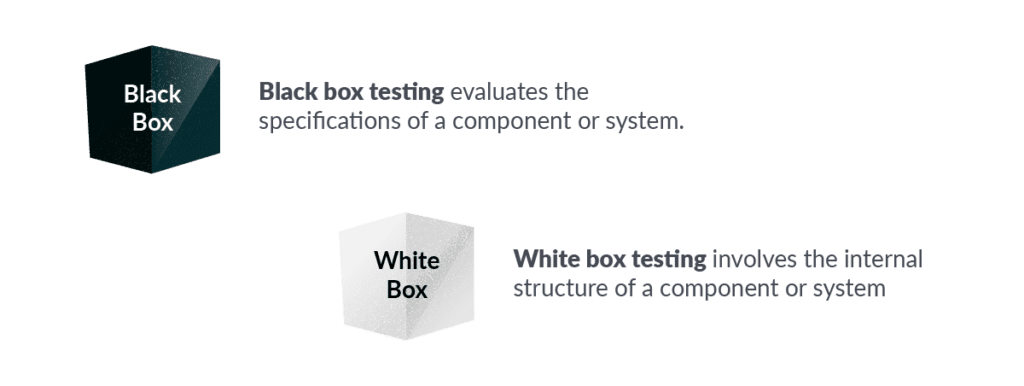What’s the difference between Black Box and White Box Testing?
When looking at black box vs white box testing, the main difference between them is the type of product information the tester will access. Black box testing focuses on the requirements to ensure the system responds as expected, according to the documentation. White box testing examines the system’s internal structure and architecture. Black box testing focuses on the requirements to ensure the system responds as expected, according to the documentation. White box testing examines the system’s internal structure and architecture. To understand better, let’s dive a little deeper into each definition.

Black box testing evaluates the specifications of a component or system. This means the person doing the testing bases their inquiries on the requirements provided for the system. They are not concerned with how the system works, only that it performs as expected according to the requirements.
White box testing involves the internal structure of a component or system. The internal structure can mean code, architecture, integrations like APIs or other third-party systems, or any other type of backend knowledge. White box testing is also known as clear-box or code-based testing. Developers typically do white box testing earlier in the software development lifecycle (SDLC) than black box testing.

An Example of White Box vs Black Box Testing
Let’s use an example so we can understand a little better. Let’s say we are starting a new project, such as a website for a pizza restaurant. Our team will develop and launch an in-store app allowing patrons to place orders using a kiosk. The kiosk has a credit card terminal attached so the patrons can pay as they order. For this project, we have one backend developer, one frontend developer, and two testers:
- The backend developer will write code for the functions on the kiosk, like calling the database, the API, or other integrations.
- The frontend developer will write code for the User Interface (UI) and specific functions for the frontend.
- The first tester will be responsible for testing the kiosk hardware and UI and performing exploratory testing.
- The second tester will be responsible for API and data integrity testing by correctly validating data saved in the database.
With the information above, we can come to the following conclusions:
- The backend developer can perform white box testing but not black box testing because he knows how the system is structured.
- The frontend developer may be able to perform either form of testing, depending on their knowledge and role on the team, but they cannot do both.
- The first tester can perform black box testing but not white box testing because she is unfamiliar with the backend or the system’s architecture.
- The second tester may be able to perform white box testing or black box testing, depending on their knowledge and methods used to test the API and data, but they will not do both.
Difference between Black Box and White Box Testing
There are many differences between black box and white box testing. The key differences are listed below.

Knowledge – What the tester knows is probably the main difference between white box and black box testing. A developer who has worked on the project understands how the system works already, so should not do black box testing. They can still perform functional and system tests, but because they cannot unlearn what they already know, there would always be some level of bias through knowing how it works. Alternatively, a stranger could perform black box testing and would probably be quite good at it.
Furthermore, there are different levels of knowledge among those who can perform black box testing. Say you are testing a point of sale (POS) terminal, and you have a technology background or previous experience working with POSs; it’s likely your perspective will already be informed. Your level of knowledge will still be limited to the user interface, but it may be on a higher level because you know how a POS is supposed to work. Another tester may not have used a POS before, or maybe they lack a technological background, so their level of knowledge will be very basic. Either way, knowledge is the key difference.
Measuring Coverage – Black box test coverage is based on the number of test cases performed and their passing or failing results. White box test coverage can be measured by the amount of code coverage. Tools are available to calculate the percentage based on the number of statements within a codebase.
Time Requirements – White box testing typically takes longer and can be tedious. Creating unit tests, writing and maintaining automated tests, and analyzing code coverage require more time and effort than most black box testing techniques.
Techniques – White box test techniques typically involve writing code, while black box test techniques do not. The posts White Box Testing and Black Box Testing have in-depth information on the respective testing techniques.
Responsibilities – Usually, developers perform white box testing through unit testing, statement coverage, or API testing. Developers are best to do this because they use code to test their code. Testers in the QA department typically do black box testing because they perform functional and system tests. However, sometimes a tester may be able to perform white box testing.
Benefits – Both black box and white box testing have benefits, but neither approach is better than the other. White box testing typically occurs earlier in the SDLC, meaning defects can be found sooner, making them easier to resolve. White box testing also provides broader test coverage, which means defects are less likely to be found later in the SDLC. Black box testing can improve the eventual user’s experience because the tester performs actions with the mindset of an end user.
Conclusion
Black box vs white box testing reveals that the aims and techniques used are dissimilar. Typically, they are done at separate times within the SDLC and performed by different team members, i.e., developers vs testers. The main difference between the two is the type of knowledge a tester has. Neither technique is better than the other, but together, they can provide extensive test coverage on a system.
About the writer
Faith Quinn
Faith Quinn is a Lead QA Engineer with more than a decade of QA experience, including PCI and SOX.
All Faith Quinn's articles
